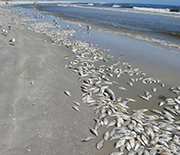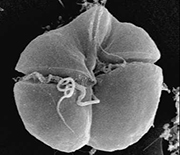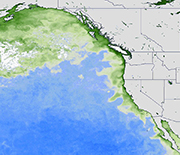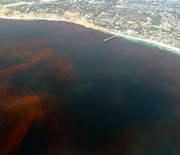News Release 18-078
NSF, NIEHS award $30 million for new research on links among oceans, lakes and human health
Awards focus on marine and Great Lakes pathogens, such as toxins in harmful algae blooms

A red tide, or harmful algae bloom, is tainting Gulf of Mexico waters off Southwest Florida.
September 13, 2018
This material is available primarily for archival purposes. Telephone numbers or other contact information may be out of date; please see current contact information at media contacts.
Summer 2018. The west coast of Florida. A red tide spreading along this Gulf of Mexico shoreline has killed millions of fish, threatened the health of human residents and affected tourism in the region. Nationwide, such harmful algae blooms cost an estimated $50 million each year.
What led to the Florida "bloom" of harmful algae, and what short- and long-term effects might it have on people and other animals -- and on the gulf ecosystem?
To study the effects of harmful algae blooms and other ocean and Great Lakes pathogens, the National Science Foundation (NSF) and the National Institute of Environmental Health Sciences (NIEHS), one of the National Institutes of Health, have awarded new grants totaling $30 million. The grants fund research on ecosystems in the oceans and in the Great Lakes Basin.
To guard against potential health threats, the links between oceans, lakes and human health must be better understood, said Hedy Edmonds, a program director in NSF's Division of Ocean Sciences, which co-funded the awards.
The new NSF-NIEHS awardees are working to provide answers.
"These projects bring together scientists doing basic research on the oceans and Great Lakes with those in biology and human health to study processes that affect millions of people," Edmonds said.
Areas the awards will focus on include:
- The effects of toxin exposure on susceptibility to chronic diseases such as heart failure, kidney disease and diabetes.
- The effects of chronic low-level exposure to multiple environmental toxicants, such as algae toxins, metals, endocrine disruptors, pharmaceuticals, persistent organic pollutants and other ocean and Great Lakes contaminants.
- The relationship between diseases in fish and harmful algae blooms.
- The links between human disease incidence and exposure to algal toxins.
"These grants will allow us to better understand the public health risks associated with environmental exposures in marine coastal regions and the Great Lakes Basin," said Fred Tyson, a program director in NIEHS' Division of Extramural Research and Training.
Grantees are developing new tools for looking at how human and other animals' cellular systems relate to oceans and health, designing tests for exposure to the toxins in harmful algae, and pursuing the discovery of new toxins.
Three center and four research project awards have been made.
The centers are headquartered at the Woods Hole Oceanographic Institution, Bowling Green State University and Florida Gulf Coast University. Research grants have been awarded to scientists at the Scripps Institution of Oceanography, University of Maryland College Park and University of Washington.
NSF-NIEHS Oceans and Human Health Center Awards
Woods Hole Center for Oceans and Human Health, John Stegeman, Woods Hole Oceanographic Institution
Scientists at the Woods Hole Center for Oceans and Human Health are working to protect public health through a better understanding of how ocean and environmental processes affect toxin-producing algae species, and are identifying human risks from exposure to these species' powerful neurotoxins.
Lake Erie Center for Fresh Waters and Human Health, George Bullerjahn, Bowling Green State University
Researchers at the Lake Erie Center for Fresh Waters and Human Health are investigating the environmental factors that influence the growth and toxicity of harmful blooms of cyanobacteria, or blue-green algae, in Lake Erie.
Greater Caribbean Center for Ciguatera Research, Michael Parsons, Florida Gulf Coast University
Biologists at the Greater Caribbean Center for Ciguatera Research are studying ciguatera fish poisoning and the environmental factors influencing its occurrence. Ciguatera fish poisoning affects tens of thousands of people each year; it's caused by the consumption of seafood, primarily reef fish, that carry ciguatoxins.
NSF-NIEHS Oceans and Human Health Project Awards
Mechanisms of marine organohalogen bioaccumulation and neurotoxicity, Amro Hamdoun, Scripps Institution of Oceanography
An urgent public health need exists to better understand the relative risks and benefits of seafood consumption, scientists have found. This project on the mechanisms of marine organohalogen bioaccumulation and neurotoxicity will determine how natural and man-made organohalogen compounds, some of which are toxic, accumulate in marine food webs, and in fish and other species people consume.
Increased Risk of Chronic Disease Due to Domoic Acid Exposure with Age, David Marcinek, University of Washington
Domoic acid is a toxin produced in some harmful algae blooms. Domoic acid accumulates in seafood products and may harm marine mammals and humans who consume contaminated shellfish. At high doses, domoic acid is responsible for the neurotoxic illness known as amnesic shellfish poisoning. Symptoms include seizures, memory loss, coma and death. Aging is the single greatest risk factor for multiple chronic diseases, including those affecting brain, heart and kidney function, all of which are also targets of domoic acid toxicity. This study will investigate how the effects of domoic acid exposure change with age.
Natural sources and microbial transformation of marine halogenated pollutants, Brad Moore, Scripps Institution of Oceanography
Natural polybrominated organic compounds have recently emerged as chemicals of human health concern. These relatives of man-made halogenated persistent organic pollutants are widely distributed throughout the marine food web and accumulate in seafood consumed by people. This project seeks to advance understanding of the biology and chemistry of these marine contaminants. The result will improve guidelines and policies on fish consumption and human health.
Effects of climate change on prevalence and environmental niches of clinically important Vibrios in the Chesapeake Bay, Anwarul Huq, University of Maryland College Park
Changes in the frequency, intensity and duration of extreme weather events are likely to affect the ecology of pathogenic Vibrio bacteria in Chesapeake Bay, the largest estuary in the U.S. Human health risks from these bacteria are primarily linked with exposure during water-based activities and with the consumption of contaminated seafood. About 80 percent of Vibrio infections happen between May and October, when water temperatures are usually warmest. Predicting conditions favoring the presence of Vibrio bacteria will inform decision-makers about the best policies to protect public health. In this project, researchers will assess the impact of extreme weather events on the prevalence of Vibrio and other pathogens in Chesapeake Bay.
-NSF-
-
Dead fish line southwest Florida beaches, the result of red tide.
Credit and Larger Version -
The microscopic plankton Karenia brevis is responsible for the Florida harmful algae bloom.
Credit and Larger Version -
A 2011 freshwater harmful algae bloom turned Lake Erie a bright blue-green.
Credit and Larger Version -
In 2015, one of the largest harmful algae blooms on record fouled waters along the West Coast.
Credit and Larger Version -
A past red tide off La Jolla, California. As in Florida, ocean waters were stained crimson.
Credit and Larger Version
Media Contacts
Cheryl Dybas, NSF, (703) 292-7734, email: cdybas@nsf.gov
The U.S. National Science Foundation propels the nation forward by advancing fundamental research in all fields of science and engineering. NSF supports research and people by providing facilities, instruments and funding to support their ingenuity and sustain the U.S. as a global leader in research and innovation. With a fiscal year 2023 budget of $9.5 billion, NSF funds reach all 50 states through grants to nearly 2,000 colleges, universities and institutions. Each year, NSF receives more than 40,000 competitive proposals and makes about 11,000 new awards. Those awards include support for cooperative research with industry, Arctic and Antarctic research and operations, and U.S. participation in international scientific efforts.
Connect with us online
NSF website: nsf.gov
NSF News: nsf.gov/news
For News Media: nsf.gov/news/newsroom
Statistics: nsf.gov/statistics/
Awards database: nsf.gov/awardsearch/
Follow us on social
Twitter: twitter.com/NSF
Facebook: facebook.com/US.NSF
Instagram: instagram.com/nsfgov







